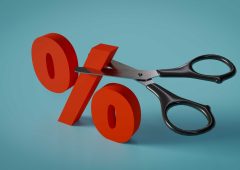BREAKING: U.S. Jobs Report is Out – Here is What You Should Know
04.10.2024 15:31 1 min. read Alexander Stefanov
One of the most important U.S. economic metrics, the jobs report, was just released by the Bureau of Labor Statistics.
The Bureau of Labor Statistics’ report on jobs in September showed that the unemployment rate falls to 4.1%, the same as in August. Тhe economy added 254,000 jobs, up from 142,000 in August.
This latest report is crucial for assessing whether the Fed’s anticipated quarter-point rate cuts in its remaining meetings this year will hold.
Before the release, former Fed economist John Roberts analyzed the Fed’s economic outlook and noted that recent rate cuts coincide with a slight projected increase in the unemployment rate, suggesting that the previous ec’onomic resilience is fading. He warned that the current policy rate may exert more pressure on the economy than expected.
Rising joblessness over the past year has raised recession alarms. Historical trends indicate that when unemployment increases by more than half a percentage point annually, larger rises typically follow.
Investors are largely betting that the Fed will cut the benchmark rate by another quarter-point in early November, a sentiment that the recently published employment data could either validate or alter. Richmond Fed President Thomas Barkin remarked that as more economic reports emerge, confidence in rate decisions will evolve, allowing for appropriate responses to changing data.
-
1
Gold Beats U.S. Stock Market Over 25 Years, Even With Dividends Included
13.07.2025 15:00 1 min. read -
2
US Inflation Heats Up in June, Fueling Uncertainty Around Fed Cuts
15.07.2025 16:15 2 min. read -
3
U.S. Announces Sweeping New Tariffs on 30+ Countries
12.07.2025 16:30 2 min. read -
4
Key U.S. Economic Events to Watch Next Week
06.07.2025 19:00 2 min. read
US Inflation Heats Up in June, Fueling Uncertainty Around Fed Cuts
U.S. inflation accelerated in June, dealing a potential setback to expectations of imminent Federal Reserve rate cuts.
Gold Beats U.S. Stock Market Over 25 Years, Even With Dividends Included
In a surprising long-term performance shift, gold has officially outpaced the U.S. stock market over the past 25 years—dividends included.
U.S. Announces Sweeping New Tariffs on 30+ Countries
The United States has rolled out a broad set of new import tariffs this week, targeting over 30 countries and economic blocs in a sharp escalation of its trade protection measures, according to list from WatcherGuru.
Key U.S. Economic Events to Watch Next Week
After a week of record-setting gains in U.S. markets, investors are shifting focus to a quieter yet crucial stretch of macroeconomic developments.
-
1
Gold Beats U.S. Stock Market Over 25 Years, Even With Dividends Included
13.07.2025 15:00 1 min. read -
2
US Inflation Heats Up in June, Fueling Uncertainty Around Fed Cuts
15.07.2025 16:15 2 min. read -
3
U.S. Announces Sweeping New Tariffs on 30+ Countries
12.07.2025 16:30 2 min. read -
4
Key U.S. Economic Events to Watch Next Week
06.07.2025 19:00 2 min. read


